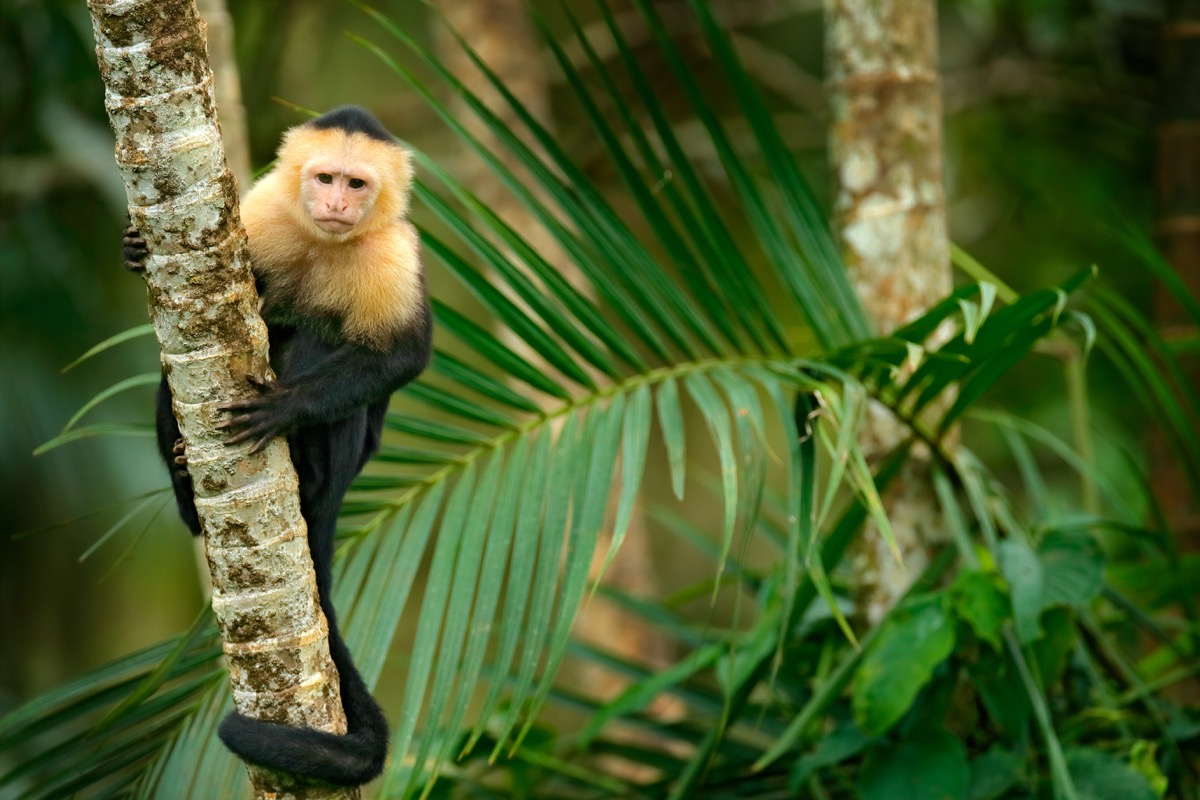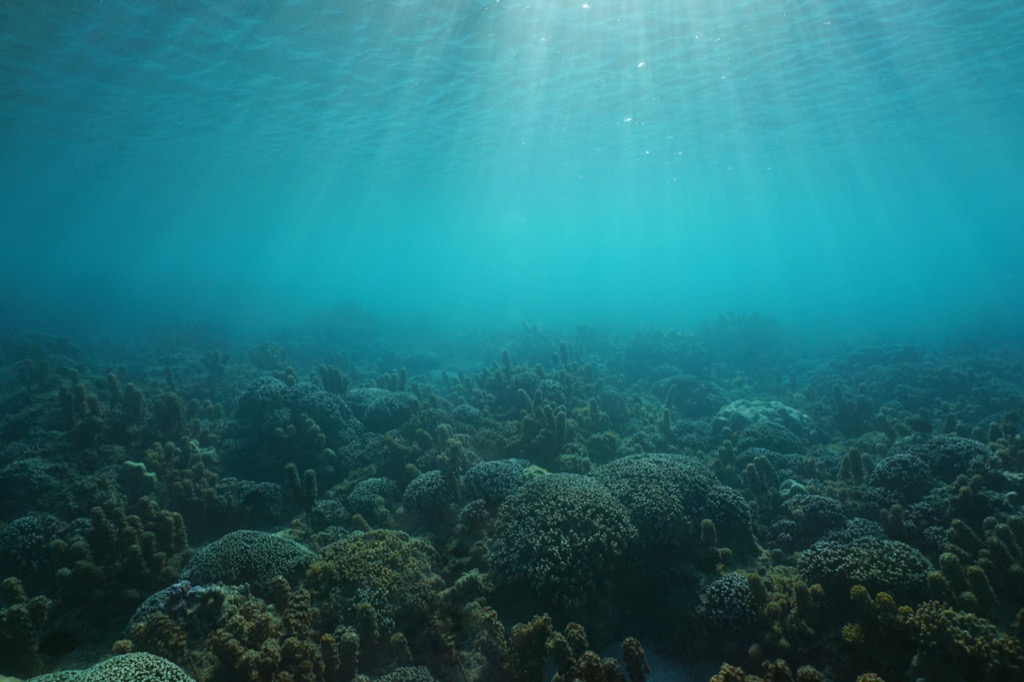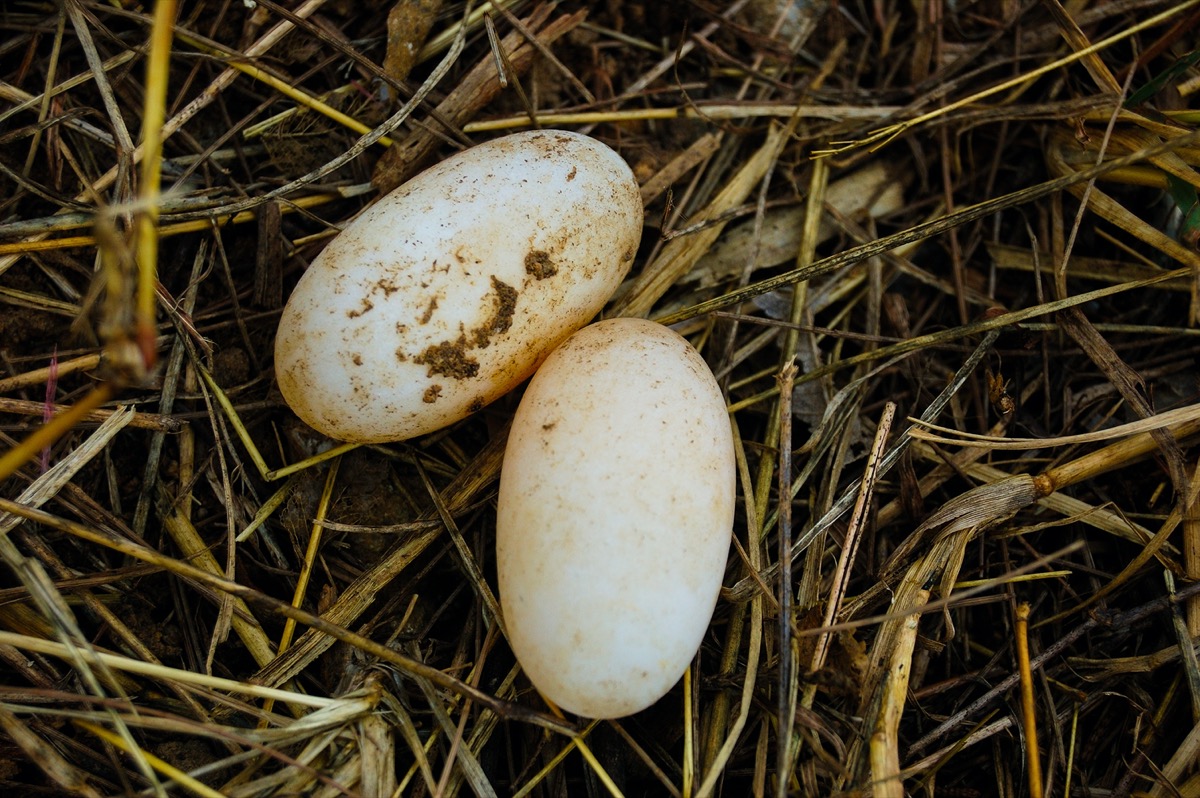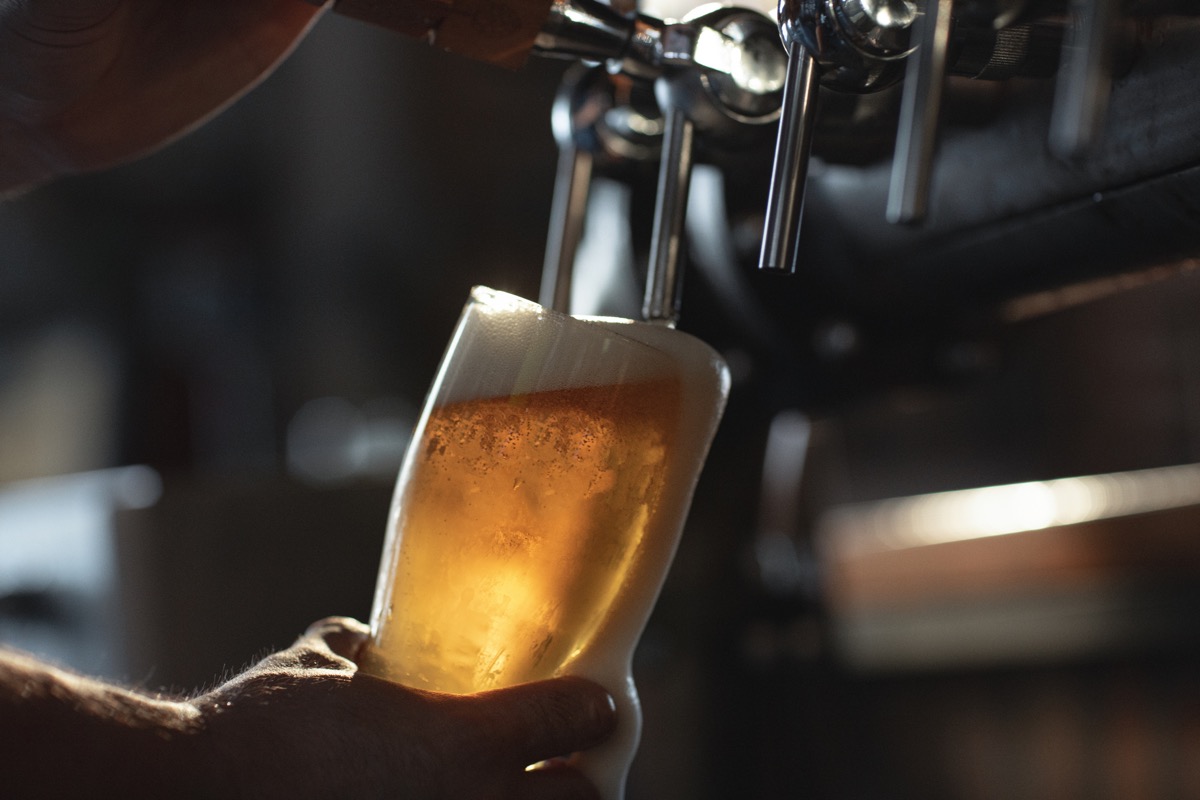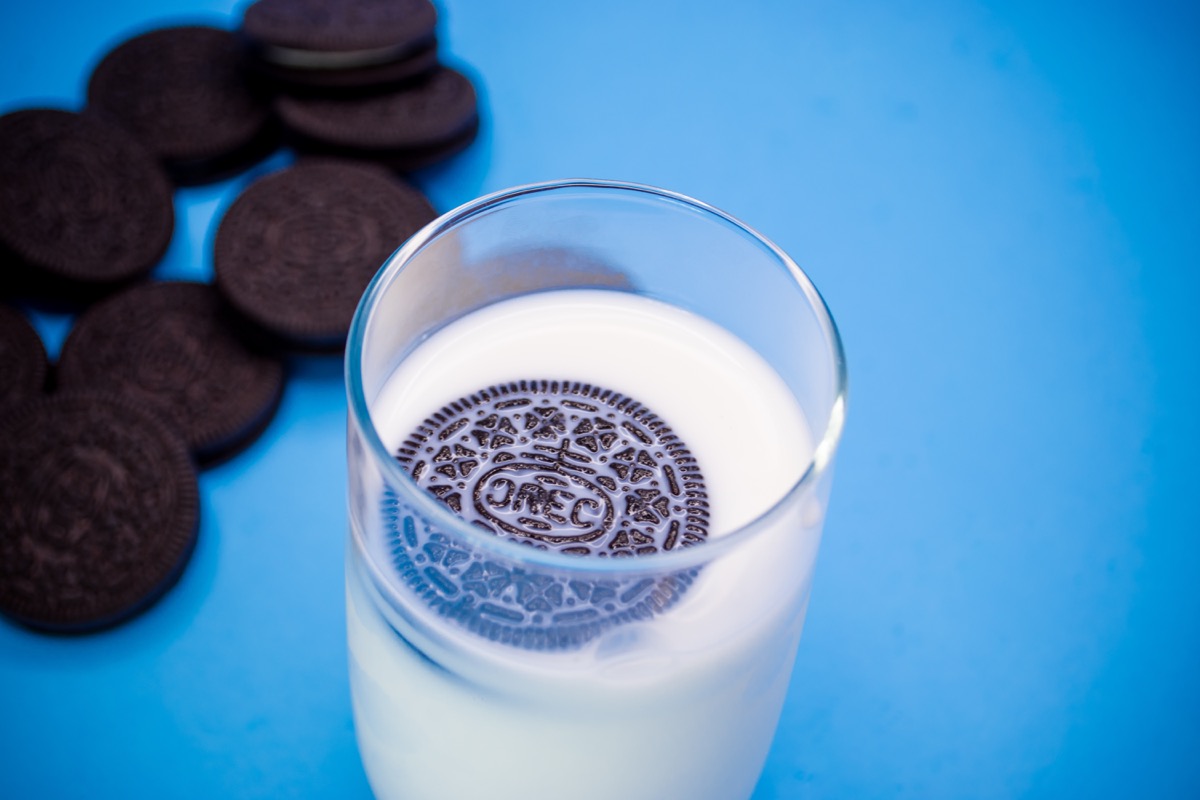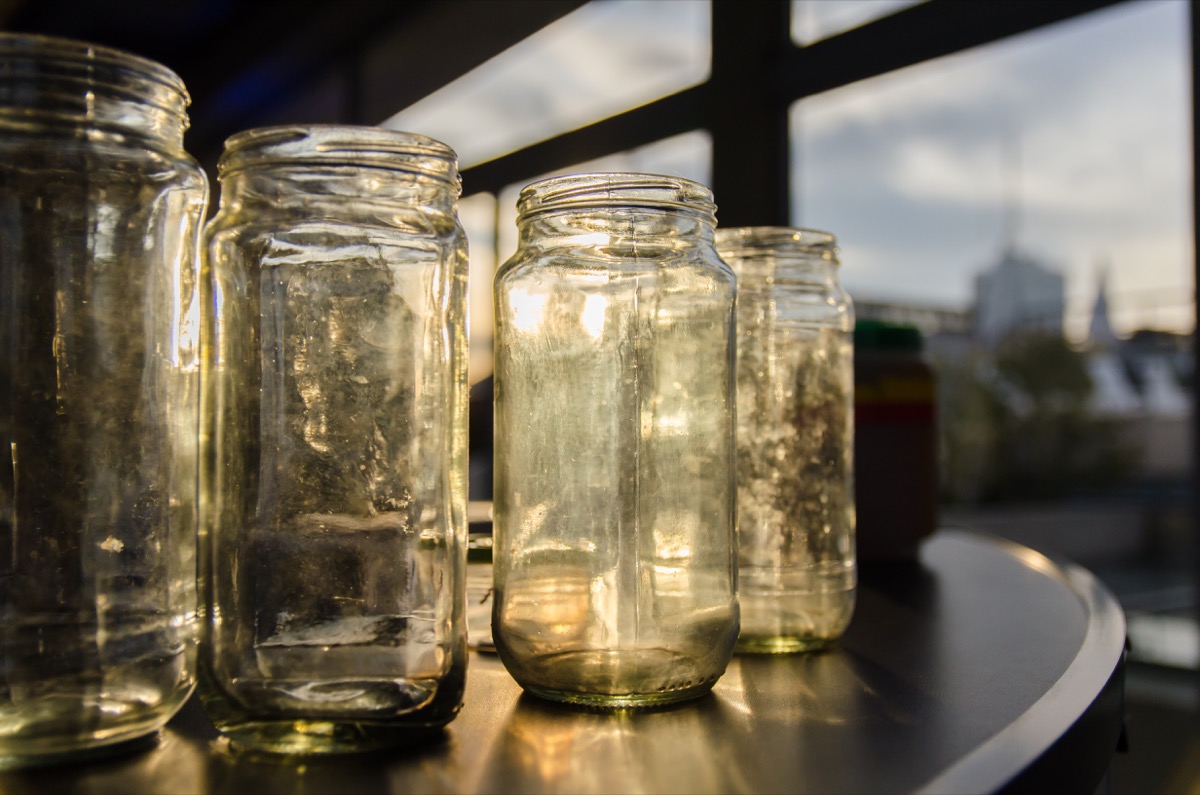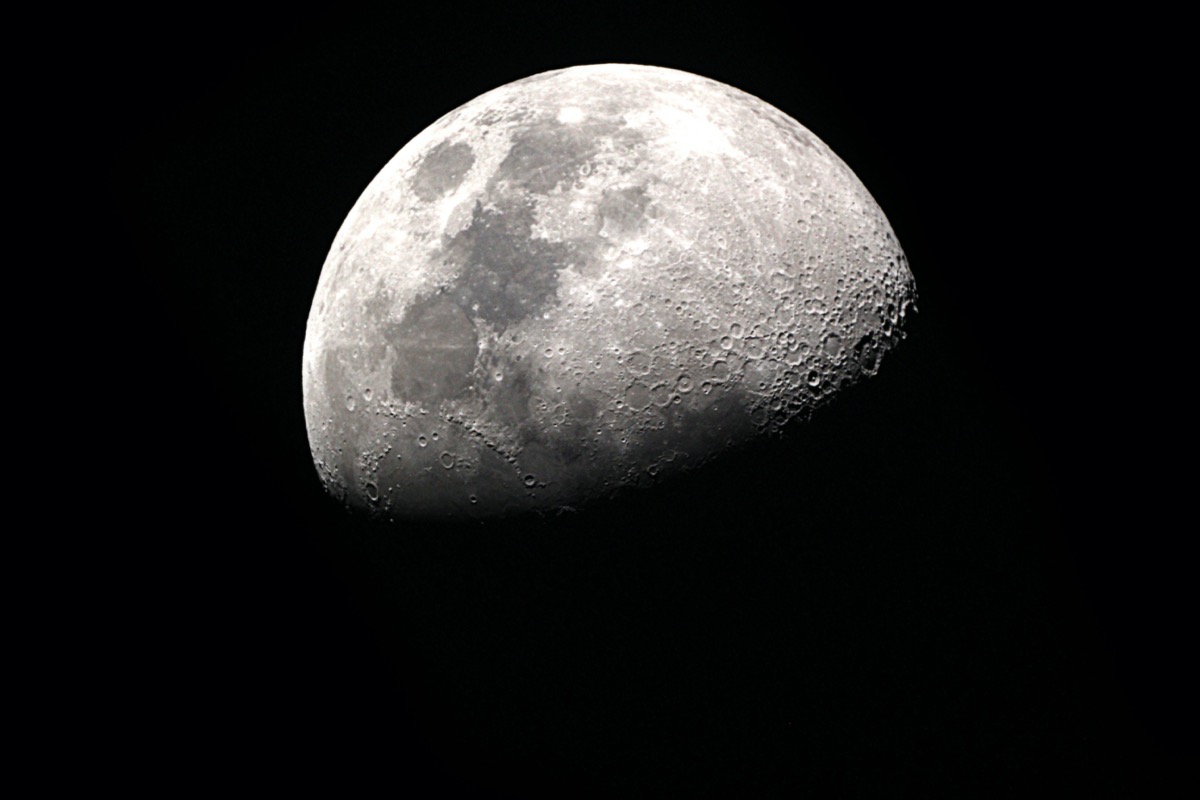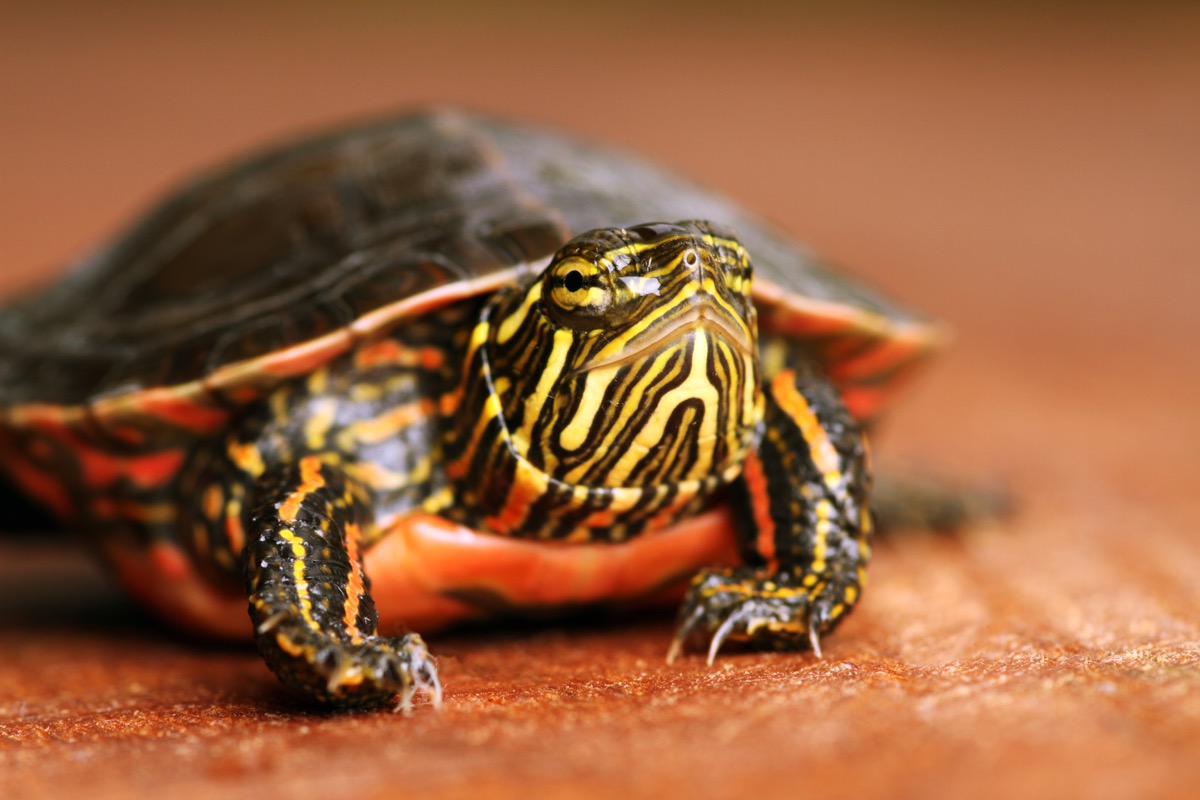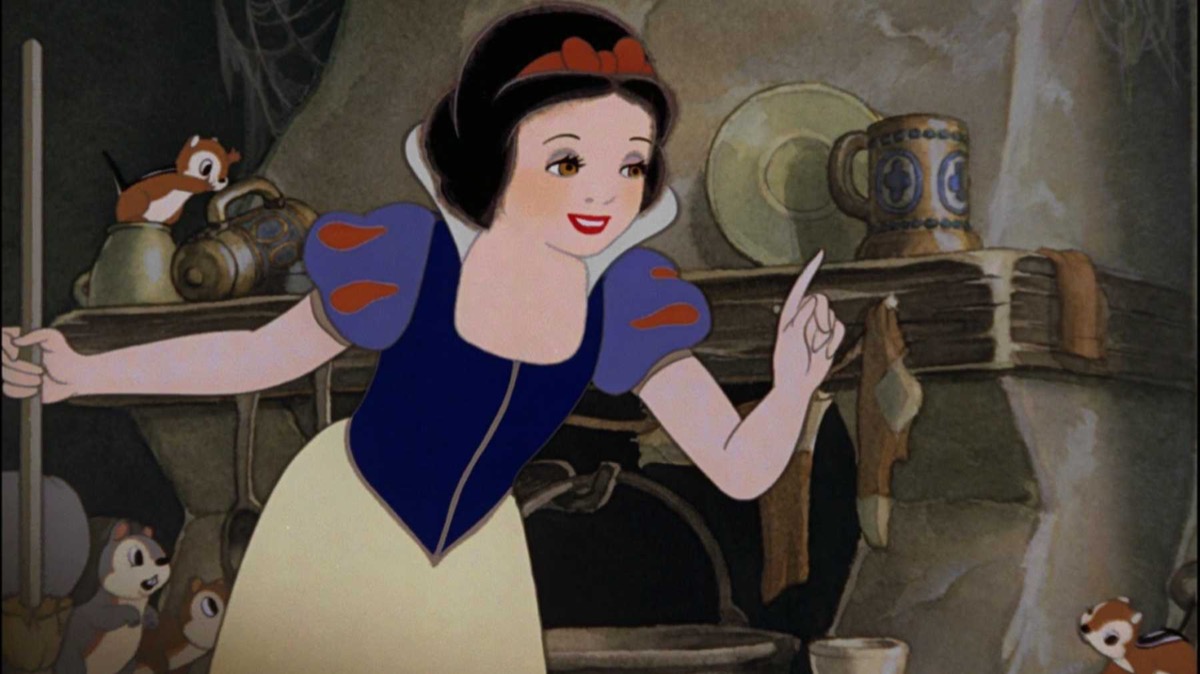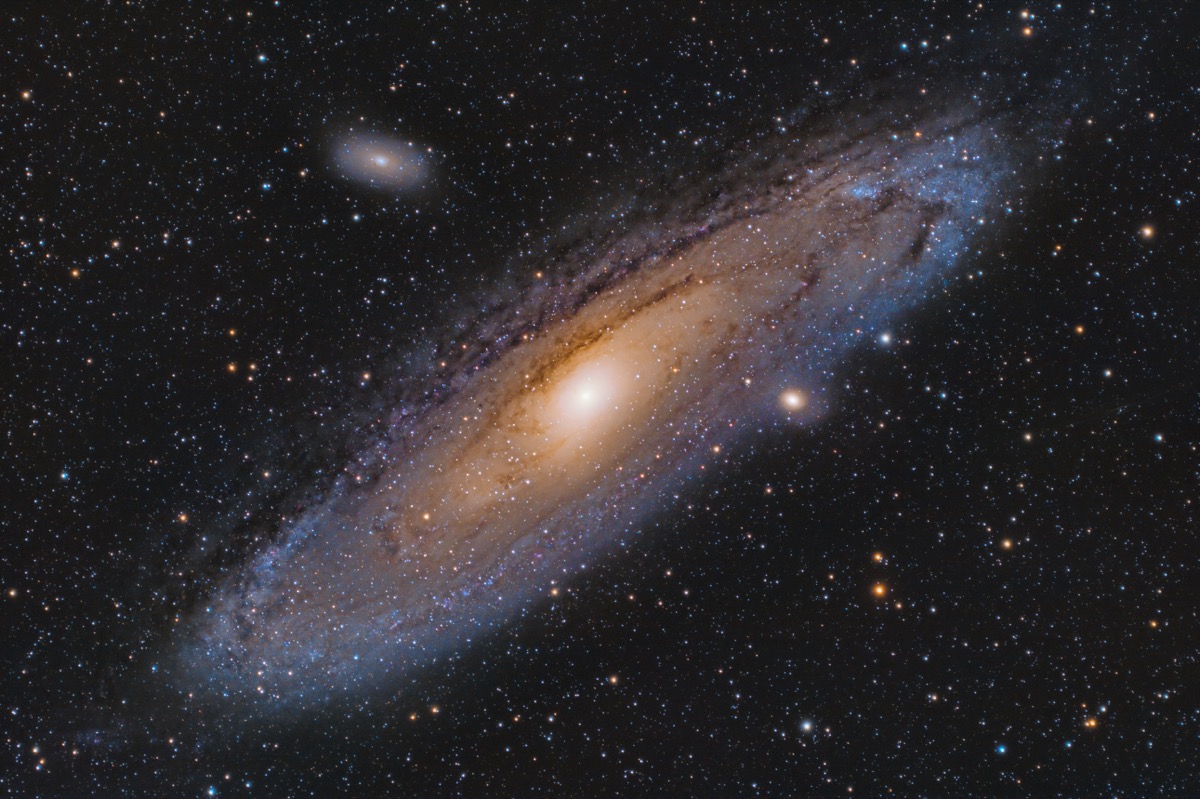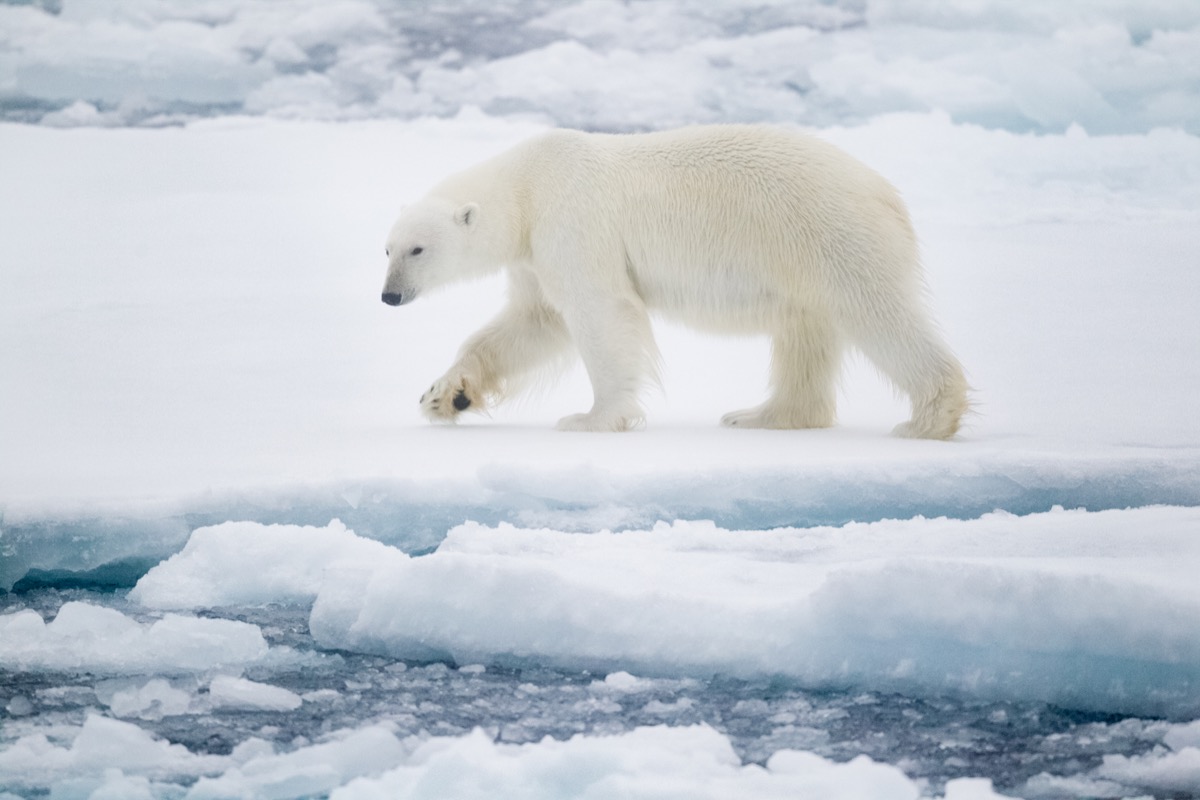If you want to set yourself on a path to reaping those incredible benefits, just like Einstein, read the 125 facts we’ve compiled here. They’re fun, they’re interesting, and they’re guaranteed to pique your curiosity. It’s time to arm yourself with all sorts of fascinating facts and trivia that will make you feel like a total genius, boosting your confidence in a flash! And to test the knowledge you already have, try answering these 50 Trivia Questions Only Geniuses Can Answer. If you happen to be around a monkey, you might be inclined to feed it a banana. But the fact is, bananas contain far too much sugar for monkeys to handle. “Giving this fruit to animals is equivalent to giving them cake and chocolate,” according to Amy Plowman, head of conservation and advocacy at the Paignton Zoo in Devon, U.K. “Compared to the food they would eat in the wild, bananas … have lots of calories and contain much more sugar that’s bad for their teeth and can lead to diabetes and similar conditions. It can also cause gastrointestinal problems as their stomachs are mostly adapted to eating fibrous foods with very low digestibility.” The more you know! And for more awesome animal information, check out these 50 Animal Facts That Will Change the Way You View the Animal Kingdom. Don’t blame your bad hand at the poker table on a stroke of bad luck; it’s really just a matter of math, seeing as there are more ways to arrange a deck of cards than there are total atoms on Earth! If a card deck is shuffled properly, there’s a pretty high chance that it comes out in an arrangement that has never existed before, because a deck of 52 cards has an astronomically large number of permutations. (Put simply: It’s a 69-digit number!) William Shakespeare had a flair for the dramatic, but he also relied on some tried and true tropes, including the ways he killed off his characters. When The Guardian broke down data from Open Source Shakespeare in 2016, they found that the majority of fatalities (54 out of the 100 deaths in all of his plays) were due to stabbings. The second most common cause of death was being poisoned, although just four characters met their maker this way. And for even more odd trivia, check out the 100 Fascinating Facts You’ll Want to Share with Everyone You Know. About 71 percent of the surface of the Earth is covered with water. However, it’s hard to fully grasp just how much water that actually is. Thankfully, NASA put it in perspective. They explain that if we were somehow able to take all of the water on the planet and bring it together, it would form a massive 860-mile wide ball. For comparison, the Earth itself is 7,917.5 miles in diameter. Everyone makes mistakes. But you wouldn’t think that one of the largest newspapers in the United States would run a typo on its front page every day for more than 100 years. However, that’s exactly what occurred when an employee of The New York Times accidentally entered the wrong serial number of an edition that went out back in 1898. Seeing that they were at issue 14,499, the editor on duty kicked it up by what they thought was one number for the next day. But instead of deeming it issue 14,500, they went up 500 editions into the future to 15,000. As a result, each issue was misnumbered from 1898 until 1999 when a news assistant finally caught the mistake! And for more facts about the world of words, learn these 40 Facts About Words That Will Blow Your Mind. When you look at the night sky and see the moon shining down, you might not have realized that it’s not alone up there. Other than the lunar body, there are two asteroids that orbit close to our planet. One asteroid, Cruithne, follows the Earth’s orbit, while Asteroid 2002 AA29 travels along a path that is shaped like a horseshoe. Because of this, it only swings by us every 95 years. Zebras are known for their striking black and white stripes, but it turns out that not all of the creatures are born with a lovely lined pattern. In fact, some rare zebras are born with spots, such as the polka-dotted baby zebra (seen above) that was spotted in Kenya’s Masai Mara National Reserve in 2019. Named Tira, the foal has a coat that is primarily dark but has white dots, a coloring thought to be due to a genetic mutation called pseudomelanism. Although the little one looks quite a bit different from the rest of his family, he seems to be fitting in just fine. Humans blink in order to keep our eyes clean and moisturized. However, it turns out that some of us blink much more than others. Specifically, adults tend to blink around 15 times per minute while babies only blink an average of two or three times in the same time span. And for more information about the human body, memorize these 33 Amazing Things You Didn’t Know About Your Own Body. The Aldabra white-throated rail may not be a very well known bird, but it’s certainly a remarkable one. The flightless creature first found itself in trouble around 136,000 years ago when it went extinct—something it’s done twice. However, a 2019 study published in the Zoological Journal of the Linnean Society explained that “the rail is an example of a rarely observed phenomenon called iterative evolution, in which the same ancestral lineage produces parallel offshoot species at different points in time.” Because of this, it’s been able to rally and “evolve” back into existence both times it was essentially wiped out. Antarctica is an amazing place that boasts incredible frosty landscapes, unbelievably low temperatures, and volcanic activity. It’s also the “windiest, driest, and iciest place on Earth,” according to National Geographic. Another thing that sets it apart? It’s the only continent on Earth that can’t naturally support grasslands. And for more information about the world around you, check out these 100 Mind-Blowing Facts You’ve Never Heard Before. Trading goods and services for currency is a system that has existed around the world for thousands of years. However, the oldest surviving banknotes are the Da Ming Tongxing Baochao (Great Ming Circulating Treasure Note) from China, which were initially printed between 1368 and 1398. When the value of the money crashed, the banknotes were simply stashed away and forgotten, which is how some managed to survive, according to Guinness World Records. The thought of a body moving after a person has died sounds like something out of a horror movie, but it may just be a natural phenomenon. According to a 2019 study published in the journal Forensic Science International: Synergy and led by Australian researcher Alyson Wilson, corpses can continue to move for more than a year after death. “What we found was that the arms were significantly moving, so that arms that started off down beside the body ended up out to the side of the body,” she told ABC News. “One arm went out and then came back in to nearly touching the side of the body again.” The movement is believed to be the result of the decomposition process which causes the corpses’ ligaments to dry out and contract, pulling the limbs as they do. Chicken eggshells are mostly made up of calcium carbonate, a substance that also exists in human bones. That’s why researchers at the University of Massachusetts Lowell (UML) believe that eggs are ideal for growing new bone for humans who have suffered injuries to their own skeleton. “There is a great need for developing new and functional materials to repair and regenerate damaged bone,” Gulden Camci-Unal, a professor of chemical engineering at UML who led the research, told Smithsonian magazine in 2019. “At our lab, we like to take unconventional approaches; we look at nature and try to see what we can use that already exists.” The next time you’re playing with an adorably fuzzy feline, you might want to notice those fluffy bits of fur that stick out of the cat’s ears, which have a super cute name: ear furnishings. When NASA’s Apollo 11 landed on the moon, it was a historic moment for all of humanity, broadcast internationally. But it was also nearly interrupted by a wind storm that blew through Australia. That’s where the Parkes dish, which would receive the broadcast signals from the moon, was located. When a wind storm with 60 mph winds slammed right into the dish, the crew on the ground kept their cool and a delay meant that the storm had time to pass over before the critical signals were finally sent around the world. According to Smithsonian magazine, “Those TV images would never have reached the world’s living rooms without the help of a crack team of Australian scientists and engineers, working in the bush a few hundred miles west of Sydney.” If you want to visit the Santa Margarida de Sacot chapel, you won’t just have to head to northeastern Spain, you’ll also have to trek down into a crater that sits inside of a 2,238-foot volcano. The original structure was built during the Middle Ages and unfortunately came down in an earthquake. However, the site is still home to a tiny Romanesque-style stone building that features a single nave and a steeple bell. Anacondas aren’t like the typical snake for plenty of reasons, including the fact that they can grow up to 30 feet in length and can weigh up to 550 pounds. Another noteworthy difference? Unlike most other kinds of snakes, anacondas don’t lay eggs but instead deliver live babies. They birth up to 40 snakes at a time, each around two feet long. If you like to tackle old-school recipes, then how about trying out the oldest known recipe in the world? Researchers at the University of Wales Institute tested an ancient recipe for nettle pudding, which dates back around 8,000 years. Although nettles are a plant that your parents may have warned you to stay away from as a child, according to researcher Ruth Fairchild, when it’s cooked with ground-down barley and water, “the sting goes out of it.” Violet Jessop may be one of the luckiest or unluckiest women in history, depending on how you look at it. The ocean liner stewardess not only survived the sinking of the Titanic in 1912, but she was also present during the Olympic ship collision in 1911 and on board during the sinking of the Britannic in 1916 (Olympic and Britannic were Titanic’s sister ships). Miraculously, none of the disasters could take Jessop down and she lived to be 83, passing away in 1971. Thanks to modern streaming services, you can watch an episode (or five) of Friends whenever you’d like. And if you’re observant, you might notice that the word “friends” is said in every single one of the 236 episodes of the show, according to Cosmopolitan. Take a trip up to Northwest Territories, Canada, and you’ll notice something about the cars that any nature-lover would appreciate: The territory has license plates that are shaped like polar bears. And while the government considered a new design years ago, the animal-inspired plates can still be spotted on vehicles traveling around the country. Charlie Chaplin may have become famous for making people laugh, but what happened to his body after the performer’s death is downright creepy. Following Chaplin’s passing on Christmas Day in 1977, his remains were laid to rest in a cemetery in the Swiss village of Corsier-sur-Vevey, which lies in the hills above Lake Geneva. However, just a few months later, on March 2, 1978, two men stole the body and contacted Chaplin’s widow, Oona, to demand $600,000 for the return of the corpse while also threatening her children. A police investigation resulted in the arrest and conviction of the robbers and the recovery of the body, which was later reburied in a concrete grave. It’s probably best not to get on a crow’s bad side. According to one 2008 study by wildlife researchers at the University of Washington—plus tons of anecdotal evidence from wildlife biologists—the highly intelligent birds are capable of remembering individual human faces, even if those who have wronged them wear a disguise. So how do crows show their distaste? They scream. “The birds were really raucous, screaming persistently,” one volunteer in the crow study told The New York Times. “And it was clear they weren’t upset about something in general. They were upset with me.” Sounds intense! Some fonts are pleasing to the eye while others irk readers for one reason or another. But it turns out that the fonts we like (and don’t like) influence us more than we may know. In an experiment for The New York Times, readers who were shown an essay in Baskerville were more likely to agree with the argument than if it was presented in any other font. Readers were least likely to agree with statements made in fonts like Comic Sans and Helvetica. Every day, the average human breathes around 22,000 times and, according to the Lung Foundation of Australia, no matter how hard a person exhales, their lungs will still have about one liter of air lingering inside, which makes the organ buoyant enough to float on water. No other organ in the human body has the same ability. There are days when you’re not in the mood to cook for yourself, which is why grabbing takeout is such a great option. And apparently, the residents of ancient Pompeii felt the same way. Before the city was destroyed by the disastrous eruption of Mount Vesuvius in 79 A.D., most people who lived in the area didn’t have a home kitchen and instead took advantage of shops called “popinae” that offered prepared food like porridge, ham, and stew. And in the same way we can peruse menus on the walls of McDonald’s or Burger King, Pompeians could check out painted frescos that featured the meals that they could order. You may have heard that Venice is sinking, but so is Chicago—and it’s going down just as quickly. According to the National Oceanic and Atmospheric Administration, the Illinois city is getting one to two millimeters lower every year (that’s four to eight inches every century). For comparison, Venice is sinking at a rate of two millimeters per year. The phenomenon is due to a glacial melt that happened around 10,000 years ago. It led to some areas rising after the weight of the ice was gone (consider what would happen if you squeezed one end of a tube of toothpaste; the other end would pop up). Now, the ground is settling again, which means it’s sinking back down. Cats apparently appreciate music as much as we do, but they don’t necessarily like the same tunes as humans. That’s why in 2015, scientists from both the University of Wisconsin, Madison, and the University of Maryland worked together to compose “cat-centric music.” Charles Snowdon, the lead author on the study explained, “We looked at the natural vocalizations of cats and matched our music to the same frequency range, which is about an octave or more higher than human voices… And since cats use lots of sliding frequencies in their calls, the cat music had many more sliding notes than the human music.” What they came up with is a song called “Cozmo’s Air.” As you already know, planet Earth is divided into four hemispheres: north, south, east, and west. But only one of the seven continents can lay claim to being located in all four, and that’s Africa. Though it hasn’t been 100 percent proven, there’s a consensus among scientists that déjà vu results when there is a split-second delay in transferring information from one side of the brain to the other, so your brain, overall, gets the information twice, essentially processing the event as having happened before. Think of it like your mind glitching and opening the same web browser twice. If you run through the list of elements found on the periodic table—hydrogen, helium, oxygen, magnesium, titanium, copper, and all of the others—there’s only one letter missing: “J.” (That is unless you’re looking at a periodic table from countries like Norway, Poland, Sweden, Serbia, or Croatia, which use the name “jod” for iodine.) Back in medieval times, shoes were basically thin strips of leather that covered the foot and didn’t provide much protection at all. Because of this, people walked the same way we naturally do when we’re barefoot: toe first, which allows us to test the surface in front of us and puts less stress on our knees. Frankly, it’s how humans walked for millennia before modern-day shoes came along, which keep our feet much safer so we can step down harder with our heels first. The natural smells of any two family members are similar, according to research out of Wayne State University. Researcher Glenn Weisfeld believes that shared scent could explain why stepchildren are often treated differently than children living with their biological parents. “I think it’s an important mechanism in how people discriminate against stepchildren,” he told New Scientist in 2001. It’s hard to imagine icebergs as anything other than gigantic snow-white mini-islands floating around the coldest places on Earth. But for years, scientists have been baffled by the occasional “emerald iceberg.” And while the color may seem odd, glaciologist Stephen Warren of the University of Washington has climbed up one of the frozen wonders to get a closer look. “What is most amazing is not their color but rather their clarity, because they have no bubbles,” he told IFL Science. “Ordinary icebergs originate as snow; as the snow is compressed under its own weight into ice, the air in the snow is closed off as bubbles. So glacier ice contains numerous bubbles, and icebergs are bright and cloudy.” After taking samples from the jade-colored iceberg, Warren found that the color was due to the fact that the icebergs were made of marine ice instead of glacial ice, and contained more iron oxide than typical ice. When the flash of a camera goes off, the eye isn’t prepared for the sudden influx of light, and the pupil doesn’t have time to restrict. You’re likely using flash in dark lighting, so your eyes have dilated to adjust to the dark room. When the flash goes off and the photo is taken, your eyes are still dilated, so the light reflects off of the red blood vessels of the choroid, which is the layer of connective tissue in the back of the eye that nourishes the retina. Star Wars may have taken place “a long time ago in a galaxy far, far away,” but the movie-makers responsible for coming up with Princess Leia’s iconic hairstyle for the film were inspired by some very real-life warriors. In particular, the soldaderas, or the female Mexican rebels who fought against the dictatorship of Porfirio Díaz around the beginning of the 20th century. It’s believed that director George Lucas based Leia’s double buns on a picture of Clara de la Rocha, who was a colonel in the Mexican Revolution. Kicking back with a pint isn’t as modern as you might think. In 2016, archaeologists in the Central Plain of China discovered “beer-making tool kits” in underground rooms that were built between 3400 and 2900 B.C. The equipment included funnels, pots, jugs, and a pottery stove. Scientists used the residue they found inside of the tools to deduce the 5,000-year-old beer recipe, which they published in the Proceedings of the National Academy of the Sciences. While astronauts are floating around in space, they aren’t subjected to the pressure of Earth’s gravity. As a result, the vertebra in their spines can expand and relax, which means their bodies stretch up to three percent taller. That means that someone who’s six feet tall could grow up to two inches while they’re in space. However, the additional height is only temporary. When astronauts return to Earth, they shrink back down to their normal size within a few months. As far as national security goes, songs are typically fairly harmless. But back in the 1960s, parents across the country became upset by a rumor that claimed the song “Louie Louie” by The Kingsmen contained inappropriate subliminal messages. The FBI stepped in and spent more than two years putting the tune through various audio tests. And despite producing a 120-page report, the feds merely concluded that the song is “unintelligible at any speed.” Humans come in all shapes and sizes, but in general, women tend to be smaller than men in various ways—and that includes the tongue. While the average length of men’s tongues is around 3.3 inches, women tend to have tongues that are slightly smaller at 3.1 inches. You know about identical twins (when two babies result from the same fertilized egg) and fraternal twins (when a women releases two eggs and they’re both fertilized), but did you know that semi-identical twins also exist?ae0fcc31ae342fd3a1346ebb1f342fcb Only two pairs have ever been identified and the most recent pair was a boy and a girl born in Brisbane, Australia, just a few years ago, according to research published in the New England Journal of Medicine in 2019. “The Brisbane twins are likely the result of one egg being fertilized by two sperm cells, resulting in three chromosomes,” according to IFL Science. “These three chromosomes were equally divided into two bunches of cells that then became two embryos.” In July 2019, underwater cinematographer Dan Abbott and wildlife biologist and presenter Lizzie Daly were diving in the U.K.’s Celtic Sea when they came across something incredible: a giant barrel jellyfish (Rhizostoma pulmo) that was as big as the humans themselves. Abbott was able to capture a video of the creature. These jellyfish are not even as big as the lion’s mane jellyfish (Cyanea capillata), which can float around the ocean at a full length of 120 feet. In Brazil, doctors lacking the supplies medical professionals in the United States might use are instead utilizing tilapia skin to bandage and treat second- and third-degree burns. The fish skin reportedly cuts down on healing time, reduces the need for pain medication, and helps with scarring, due to the abundant amount of collagen proteins. In 2018, scientists from Nanyang Technological University in Singapore also discovered that, in general, fish scale-derived collagen can help heal wounds. In 2015, a man in Texas tried to shoot an armadillo that he found wandering around his yard and got quite a surprise: Armadillo shells are bulletproof. The unlucky fellow made this discovery when he fired his gun and the bullet ricocheted off of the animal only to hit the man in the jaw, which he had to have wired shut when he was taken to the local hospital. If you like to enjoy the classic combination of milk and cookies, but hate when your cookie gets too soggy, you’re not alone. That’s why researchers at Utah State University in 2017 conducted tests to determine the ideal length of time you should let your cookie soak in milk. Their findings? Four seconds. That timeframe is backed up by a professor of physics at the University of Bristol who came up with a complicated equation in the 1990s that determined that the ideal length of time for dunking a British biscuit was three-and-a-half to five seconds. It’s easy to get a kick out of kangaroos thanks to their impressive hopping abilities, but Australia is facing a problem when it comes to the multiplying marsupials. In recent years, the number of kangaroos has nearly doubled down under, from about 27 million in 2010 to almost 45 million in 2016. In order to deal with the population that’s quickly gotten out of control, experts are encouraging residents to eat the kangaroos. Speaking of eating odd animals, the “Father of Evolution,” Charles Darwin, always had a taste for unusual cuisine—he was even a member of The Glutton Club while a student at Cambridge University. And according to io9, “He ate the iguanas he studied on the Galapagos. He ate armadillo, which he claimed tasted like duck. He ate puma. The lesser rhea, known to scientists as Rhea darwinii, got its name because Darwin sent the few bits of it he hadn’t eaten to London.” According to Foodbeast, the scientist had been enjoying the large flightless rhea bird for Christmas dinner. The bark of older Redwood and Sequioa trees builds up over time to protect them from the elements. The bark, which can grow up to one foot thick, contains tannin, which provides protection against fire and fungus. Tannin solutions are actually used regularly in contracting wooden buildings to mitigate any potential for fire damage. Picasso is one of the most famous names in the art world. But it turns out his real name was actually a little longer than what we’re used to hearing. In fact, it was a lot longer. The painter’s full name was Pablo Diego José Francisco de Paula Juan Nepomuceno María de los Remedios Cipriano de la Santísima Trinidad Martyr Patricio Clito Ruíz y Picasso. Fort Knox is one of the most secure places in the United States, which is why it shouldn’t shock anyone that visitors aren’t welcome at the guarded facility. However, it may surprise you to learn that even our country’s leaders aren’t given permission to visit. In fact, only one president—Franklin D. Roosevelt—has ever been inside the vault; that was way back in 1943. In May 2019, the Australian National University announced that “mysterious jars of the dead” had been “unearthed” in Laos. While researchers and scientists aren’t quite sure what the curious containers were originally meant for, they “believe they were related to [the] disposal of the dead.” The 137 jars were discovered in a remote forest area in addition to others that had been found in the past. “These new sites have really only been visited by the occasional tiger hunter,” said Nicholas Skopal, the PhD student who made the discovery. “Now we’ve rediscovered them, we’re hoping to build a clear picture about this culture and how it disposed of its dead.” A bruise is caused by bleeding under the skin; tiny capillaries (blood vessels) are crushed, which expel blood that’s trapped under the skin. Initially, the bruise will just look red because the blood is still oxygen-rich. Within one to two days, the blood begins to lose its oxygen, turning purple. Then, after three or more days, bruises will start to turn green, yellow, or grey thanks to compounds called biliverdin and bilirubin that break down the hemoglobin to absorb vitamins and minerals (like iron) for the body to use. The rest of the waste is eventually purged from or absorbed by the body. If you text “OMG” to your friends, you might think that you’re using a modern acronym. But it turns out that the first appearance of the three-letter expression was in a letter to Winston Churchill in 1917. Lord Fisher, an admiral and naval innovator, wrote to the British prime minister and was obviously excited about a possible honor for himself and those in his line of work. He wrote,“I hear a new order of Knights in on the tapis—O.M.G. (Oh! My God!)—Shower it on the Admiralty!” Before archaeologists decided that a cactus spine tool was, in fact, the earliest evidence of tattooing in the U.S., the peculiar object was merely seen as an “odd-looking little artifact,” according to National Geographic. Made from prickly pear cactus spine needles and a handle carved from lemonade sumac, the item was then bound with yucca fiber and the tips dipped in dark pigment in order to produce body art around 2,000 years ago. That’s 1,000 years earlier than historians previously thought that the art had first been practiced in the Southwest. Snuffleupagus—or Mr. Snuffleupagus if you’re fancy—is a beloved character on the long-running children’s television show Sesame Street. And while millions of kids adore the big (and big-hearted) creature, they may not have known that his first name is Aloysius. If it seems like your puppy pal is always aware of your mood, it’s because their highly sensitive nose does, in fact, alert them to your emotional state. According to Psychology Today, dogs can not only tell when you’re happy, but they can also smell human fear by picking up “chemosignals,” which are body odors produced in human armpits. If you need to relax, try putting on “Weightless” by the Marconi Union. A 2017 study led by David Lewis-Hodgson, PhD, of Mindlab International, found that the tune is the “most relaxing song on Earth,” reducing listeners’ stress and anxiety by 65 percent. The song was so successful when it came to chilling people out during the study, that Lewis-Hodgson said, “I would advise against driving while listening to the song because it could be dangerous.” An atom is more than 99 percent empty space and they are ridiculously tiny. For an idea of how small, exactly, know that just one strand of your hair is about 1 million atoms thick. This is all to say if you were to take out all of the empty space in atoms, and then compress all of the atoms so they were physically touching, all of the human beings on the planet would be about the size of an apple. While most people in North America grab a bag of popcorn when they go to the movies, that’s not the case everywhere. For instance, if you were to see a film in Colombia, you could try out roasted ants called “hormiga culona.” And if you’re heading to the theater in Norway, you can enjoy dried reindeer meat. There are plenty of things to be afraid of, including heights, small spaces, and, of course, spiders. But there are people who actually have a phobia about phobias themselves, which is called phobophobia. The Eiffel Tower in Paris is made up of more than 7,300 tons and 1,063 feet of iron. But during the summer heat, the structure’s metal expands, which means that it can grow more than six inches in height during the sizzling season. Canadians are well-known for being incredibly polite, perhaps even to a fault. That’s why in 2009, the province of Ontario passed the “Apology Act,” which states that saying “sorry”—which can be an expression of sympathy or regret—can’t legally be considered an admission of guilt or fault. We may call it “pitch black,” but what you’re seeing is “eigengrau,” which is “dark light,” often referred to as “brain grey.” It’s the completely uniform dark (almost black) gray background that many people report seeing in the absence of light. Some people prefer to call what they see “visual noise” because it’s an ever-changing field of tiny white and black dots. Today, YouTube is the place to go for makeup tutorials, toy reviews, and music videos. But when the site was founded on Valentine’s Day in 2005, it was meant to be a dating app where singles could upload video profiles. Years later, YouTube cofounder Steve Chen explained, “We always thought there was something with video there, but what would be the actual practical application? We thought dating would be the obvious choice.” While there are 10 federal holidays in the U.S., only two celebrate birthdays. Presidents’ Day started as a celebration of George Washington’s birthday, who was born on Feb. 22, 1732. Today, it’s celebrated on the third Monday in February. And Martin Luther King Jr. Day is held on the third Monday of January, which tends to fall close in date to King’s actual birthday on Jan. 15. It was observed for the first time on Jan. 20, 1986, three years after former president Ronald Reagan made the holiday official. While German Chocolate Cake sounds like something that originally hailed from Berlin or Munich, it wasn’t named after its country of origin. Instead, it was named after baker Sam German, who invented the chocolate in the cake, but not the recipe. In 1852, German, who was either American or English—not German—came up with a special kind of baking chocolate for the Baker’s Chocolate Company, which named it after him, i.e. “German’s Chocolate.” When a woman in Texas used the chocolate for her cake recipe and submitted it to a Dallas newspaper more than a century later in 1957, she named the dessert “German’s Chocolate Cake.” In time, the possessive “’s” was dropped and it became German Chocolate Cake. There’s only one human who’s made the moon their final resting place. Eugene Shoemaker was considered one of the founders of planetary science and after a career filled with stellar accomplishments, he spent his days traveling around the world to study impact craters. When he passed away in 1997 during one of his trips, his wife, Carolyn, who had once discovered a comet with her husband, sent his ashes to the moon in a metal cylinder that was inscribed with a quote from Romeo and Juliet: “And, when he shall die/Take him and cut him out in little stars/And he will make the face of heaven so fine/That all the world will be in love with night/And pay no worship to the garish sun.” In 1941, lyricist Oscar Hammerstein II won his first Academy Award for Best Original Song thanks to the lyrics he wrote for “The Last Time I Saw Paris” from the film Lady Be Good. The win also made him the first person to take home an Oscar who shared a name with the award’s statue. According to Portable Press, he’s still the only Oscar to ever win an Oscar. And he won a second for Best Original Song in 1945, so this one Oscar has two Oscars to his name. When researchers in a 2012 study published by the American Psychological Association exposed a group of people to five different conditions—some participants watched a horror video while others saw a happy clip, some did a little exercise while others did twice as much, and the fifth group did nothing at all—the majority of subjects had the same reaction afterward when viewing art, except those who had watched the scary video. The study found that those who had watched the horror scene rated the art they were later shown as “sublime” and were able to appreciate it more than those who had not been left fearful. The next time you think of the perfectly witty response hours—or even days—after someone says something snarky to you, you’ll know what to call the frustrating experience. “Treppenqitz” is the German word for thinking of a comeback too late. It literally translates to “staircase joke” because “the witty retort usually hits you in the stairwell on your way out. Of course by then it’s already too late to use it,” notes DW Akademie. According to Mental Floss, “the French have a word for this, too: esprit de l’escalier—literally, ’the spirit of the staircase.’” Unless you get a little creative with your pronunciation, you won’t find any rhyming words in the English language for month, bulb, wolf, walrus, rhythm, husband, or woman. That is unless you choose to consider old-fashioned words that are no longer in use, such as culb, the little known 17th-century word for a snippy reply, and smitham, which refers to fine-malt dust or powdered lead ore. Located in Fez, Morocco, the University of Karueein (or University of Al Quaraouiyine) was founded all the way back in 859 A.D. It has continued to operate for more than a thousand years, which earned it the Guinness World Record for “Oldest higher-learning institution, oldest university.” In 1963, it was incorporated into Morocco’s modern state university system; nearly 8,000 students enroll each year. In 1943, Ingvar Kamprad, who was 17-years-old at the time, was given money from his father as a reward for doing well with his schoolwork. With his earnings, the teen decided to start his own business. To name it, he used his own two initials (I and K) as well as the first letters of the name of the farm and village where he grew up, Elmtaryd (E) and Agunnaryd (A). Put them all together and you have IKEA. If you were to guess what sort of animal is the elephant’s closest relative, you might be picturing something large with an elongated nose. But you’d be way off the mark. Instead, you’d need to take a look at the rock hyrax, a small rodent-like mammal that lives in Africa and the Middle East. While the two animals seem like they have nothing in common, they descend from a common ancestor and both have tusks and flat nails. They also have another closely related mammal relative: the manatee. On March 6, 2019, NASA’s Solar Dynamics Observatory, which is in orbit around Earth, captured a strange phenomenon in space: The moon was crossing in front of the sun, then suddenly seemed to stop before it began to move backwards. According to NASA, the unusual optical illusion was due to the fact that “a celestial object appears to move backwards because of the way that different objects move at different speeds at different points in their orbits.” The same effect occurs when you’re driving and pass a slower car—it will appear to be going backward for a moment as you move ahead. We have all kinds of words for important gatherings where networking happens and decisions are made: meetings, conferences, conventions, assemblies, legal proceedings. But back in the days of the Vikings, communities would come together to decide on laws and conduct cases (as well as hand down judgments) at gatherings called “things.” When professor Ernő Rubik invented the Rubik’s Cube in 1974 to teach his students about 3-D geometry, even he couldn’t solve the puzzle he had created. He famously wrote that it was like “staring at a piece of writing written in a secret code. But for me, it was a code I myself had invented! Yet, I could not read it. This was such an extraordinary situation that I simply could not accept it.” Despite his initial inability to take down his own toy, he eventually learned to master the cube and could solve the puzzle in under a minute. The Mona Lisa may be the most famous painting in the world, but she’s not actually an original. There are multiple copies of the Mona Lisa all thought to be painted by Leonardo da Vinci, though some may have been made by his students who were attempting to copy their master’s work as practice. Along with the Mona Lisa in the Louvre, there’s also the Isleworth Mona Lisa, the Prado Museum La Gioconda Mona Lisa, the Hermitage Mona Lisa, Salaì’s Mona Lisa, and even a nude version. Oh my! You’ve probably always called the cute little creature who promotes pre-prepared pastry dough the Pillsbury Doughboy. But he happens to have a specific name: Poppin’ Fresh. He also has a wife named Poppie Fresh and two children, a son that goes by Popper and a daughter known as Bun Bun. There’s also the grandparents, Granmommer and Granpopper, as well as Uncle Rollie. And if that wasn’t enough, the family has a dog called Flapjack and a cat named Biscuit. Bagpipes may be one of the most recognizable symbols of Scotland, commonly played by kilt-clad musicians sounding songs about Loch Lomond. But the origin of the instrument has been traced all the way back to ancient Egypt where, in 400 B.C., the so-called pipers of Thebes used similar instruments made from bone and animal skin. The bagpipes may have then made their way over to Scotland in the hands of Roman invaders. Cannabis may be going through widespread legalization these days, but you probably don’t know much about its origin story. University of Vermont findings from 2019 that were published in the journal Vegetation History and Archaeobotany show that it may have first grown millions of years ago around Qinghai Lake, the largest lake in China, located on the Tibetan Plateau. Not all creatures head to warmer climates when the weather gets colder, and that means they need to adapt to the changing conditions. And while bears get cozy in caves and bees nuzzle up in their nests, painted turtles deal with their ponds freezing over in a more surprising way. As the ice restricts their access to the air above the water, instead they breathe through their behinds (specifically, their cloaca orifice) through a process called cloacal respiration. This way, the turtles are able to get oxygen directly from the water around them. If you’ve ever wondered why the Leaning Tower of Pisa is tilted, it’s due to the soft soil beneath the building’s surface. And while that might have frustrated the people who constructed the landmark, engineers have figured out that the soft soil is partially what protects the building from earthquakes. The tower’s height and stiffness as well as the softness of the soil at the building’s foundation “causes the vibrational characteristics of the structure to be modified substantially, in such a way that the Tower does not resonate with earthquake ground motion,” according to Phys.org. There are plenty of classic film soundtracks that movie-lovers and music-lovers alike enjoy listening to over and over again. But the very first film to ever commercially release a soundtrack was Disney’s Snow White and the Seven Dwarves. The movie came out in 1937 while the soundtrack—called Songs from Walt Disney’s Snow White and the Seven Dwarfs (with the Same Characters and Sound Effects as in the Film of That Title)—was released in Jan. 1938 and included tracks like “I’m Wishing,” “Whistle While You Work,” “Heigh-Ho,” and “Someday My Prince Will Come.” Today, we can pay with cash, credit, or debit, but back in the times of the ancient Mayan and Aztec people, cocoa beans were currency. The precious seeds were also a valued commodity that could be traded for other goods. According to the Museum of the National Bank of Belgium, about 10 beans could buy you a rabbit. The name “LEGO” is so well-known you’ve probably never stopped to think about where the seemingly random word comes from. But according to the company itself, “LEGO” is an abbreviation of the Danish words “leg godt,” meaning “play well.” They say, “It’s our name and it’s our ideal.” The smell of sweat is actually caused by the presence of bacteria on your skin that breaks the sweat coming out of your pores down into acids, according to the Mayo Clinic. Deodorants, which are antibacterial and often contain alcohol, work by killing the bacteria on your skin that does this. Antiperspirants, on the other hand, work by forming a gel that temporarily plugs the sweat glands on your skin, blocking them and reducing the amount of sweat that seeps through. Some pretty amazing things happen over in Andromeda, which is the galaxy right next to our own Milky Way. That includes the M31N 2008-12a star, which is actually a “recurrent nova.” That means it erupts regularly, shedding a shell of its outer layer into space approximately once a year, according to the journal Nature. With more than 162 million items in no fewer than 450 languages, the Library of Congress in Washington, D.C., is the largest library in the world, based on both its shelf space and the number of books that is on them. And when it comes to other impressive libraries, the British Library (with more than 150 million items) comes in at No. 2, followed by the Library and Archives Canada (54 million items), the New York Public Library (53.1 million items), and the Russian State Library (44.4 million items). In 2016, Forrest Fenn, a former Vietnam fighter pilot who’s also an art dealer and an author, claims that he hid a treasure chest in the Rocky Mountains that’s worth more than $1 million. Fenn told NPR, “No one knows where that treasure chest is but me. If I die tomorrow, the knowledge of that location goes in the coffin with me.” If you’re interested in heading out to look for the treasure, Fenn provides a few hints to its location in his self-published memoir, The Thrill of the Chase, along with a supposedly clue-filled poem from the book he posted on Instagram. Fenn wrote, “All of the information you need to find the treasure is in the poem. The chapters in my book have very subtle hints but are not deliberately placed to aid the seeker. Good luck in the search.” Also referred to as a “kick-up” or a “punt,” the dimple in the bottom of your wine bottle is a remnant from the past, when the bottles were made of handblown glass. If the glassblower didn’t push the seam of the bottom of the wine bottle up, it would not stand up straight (because there would be a lump). Today, a deeper punt can mean it’s a nicer, tastier bottle of wine. So run your hand underneath that bottle of vino before purchasing! Polar bears can run at 25 mph. By comparison, the fastest NFL player these days, Nick Chubb, can run just over 22 mph. When you’re trying to recall a single memory, such as a smell or the look on a person’s face, that memory can’t be recalled in isolation. That was among the 2015 findings by a team of neuroscientists at the University College London, who discovered that when we try to remember one detail (for example, the color of shoes a friend was wearing last week), we bring with it a slew of other details (such as the place where we saw said friend wearing the shoes, their other clothing, etc.). According to the researchers, this is because the brain’s hippocampus packages memories together and stores them. And when we retrieve one memory, it brings along a whole range of other components. Mummies preserved for more 7,000 years in Peru have been turning to black goo thanks to a major increase in humidity. When Harvard University scientists tested why in 2015, they discovered it’s because the microbes in the skin activate in high humidity, which is something that the people in ancient Peru never had to worry about, because of the dry desert atmosphere. However, recent changes in climate have brought fog to the region, thereby increasing the moisture in the air and melting the mummified human remains. Ethanol (alcohol) activates the vanilloid receptor-1 (VR1 for short), which is what your body activates at high temperatures (107 degrees Fahrenheit or higher, usually) to let you know that you’re getting burned. Alcohol lowers the temperature at which your VR1 receptors activate, so instead of alerting you when your temperature rises above 107 degrees, it does so when it hits 93 degrees. In other words, your receptors are telling you that your normal body temperature (98.6 degrees) feels like burning. It’s also why open wounds sting when you pour alcohol over them—and it’s why you get a burning in your throat when you pound a particularly potent shot. This “paradoxical undressing” occurs in nearly half of all hypothermal deaths. It hasn’t been fully studied because it would be pretty unethical to do so, but there are two theories at this point: It gets even weirder after that. Once undressed, the person will attempt to burrow into very small spaces. Finding bodies in states like this is why hypothermia deaths are commonly misconstrued as acts of violence. We usually think of espresso simply as concentrated coffee, but it’s more complex than that. To officially be “espresso,” the drink must be made in a particular way—produced by pressurizing near-boiling water through finely ground coffee beans packed into cakes. If the drink is made any other way (in a stovetop pot or fancy pour-over method), it’s coffee. Even if it were to taste exactly like a shot of espresso, you can’t call it that unless it’s made through the pressurized method. In other words, espresso isn’t coffee. While a few deep breaths don’t burn too many calories, this is how most burned-off fat exits our bodies. You may have thought it was through sweat, urine, or some other excretion, but the truth is, as we exercise or go about our day, most of the fat (84 percent, according to 2014 research published in the British Medical Journal) is converted into carbon dioxide and leaves our bodies through our lungs. The remaining 16 percent of the fat is converted to water, which exits our bodies through urine or sweat. In the past, a few U.S. cities have hosted the Winter Olympics, including Lake Placid in 1932 and 1980 and Salt Lake City in 2002. But back in 1932, Yosemite National Park wanted to host the international games. After installing toboggan runs and an ice skating rink, the people behind Yosemite set their sights on the Olympics. However, due to the fact that the park lacked other facilities and California didn’t have a lot of experience with winter-related competitions, the bid went to Lake Placid. The Adam’s Apple is the thyroid cartilage that surrounds the larynx. Contrary to popular belief, both women and men have one. It’s just more prominent in males because the larynx (voice box) is far larger in men (hence the deeper voices). Firefighters have a few different tactics that they can use when facing a serious blaze—and that includes the ability to make water wetter. According to International Fire Protection, a wetting agent can be used to increase the “penetration and spreading ability” of water, which is why the treated liquid is called “wet water.” Throughout the early 19th century, explorers Meriweather Lewis and William Clark trekked across the U.S. from the East Coast to the Pacific Ocean. And while they kept diligent journals, modern historians and archaeologists had for years struggled to piece together the precise locations their expedition encompassed—information that would help future generations understand this historically crucial journey. Then researchers came upon an idea for tracking their exact movements: analyzing toilet mercury. As it happens, mercury-laced laxatives were a popular solution for treating constipation during the Lewis and Clark era, and traces of mercury can be detected centuries after they are deposited. So by testing old latrine sites along the route for mercury, researchers could determine which ones the famous adventurers visited. Altogether, some 600 sites have been connected back to the famed pair. Your dry-cleaned garments are thrown into a giant front-loading washers with a liquid detergent. Yes, your clothes are completely immersed with a liquid solvent; it’s only called “dry” because there’s no water in it. Dry cleaning was originally discovered by Jean Baptiste Jolly in 1855 when his maid accidentally spilled petroleum from a kerosene lamp all over his table cloth—only to find out that it removed stains he couldn’t previously get out! Because petroleum is harmful to the environment with the amount of dry cleaning the world does, new solvents have been created over time. Naegleria fowleri is a free-living excavate form of protist that can enter the human body through the nose, then it travels from the nose to the brain where it destroys the brain tissue, invading the nervous system and consuming the brain. It has only been found in warm freshwater: lakes, rivers, and hot springs. So, perhaps you should stick to the ocean for swimming. Sound is a wave of alternating compression and expansion, so the speed of it depends on how fast it bounces back from each compression; the less compressible the medium it’s traveling through, the faster it bounces back. Water is about 800 times denser than air, so there are way more particles for waves to bounce off. Thus, sound is faster in water. However, the density has the opposite effect on physical bodies (such as, say, a bullet). Physical matter encounters drag when in the water due to its density, as laid out by the drag equation in An Introduction to Fluid Dynamics. It’s been proven that jumping into the water and swimming beneath its surface will literally save you from catching a bullet. (So all those movies and crime shows where you see people jumping into the harbor on the run have a scientific basis after all!) Carnivorous, bog-dwelling plants called bladderworts can snap their traps shut in less than a millisecond, 100 times faster than a Venus flytrap. They’re rootless floating plants that have a yellow flower at the top and an insect-digesting bladder sac. They range in size from a few inches to a few feet long. The tiny holes in padlocks serve a dual purpose: They allow any moisture that builds up inside to escape, and they allow you to add oil to the inner mechanisms to prevent rust and breakdown. Because padlocks are usually used outdoors, allowing the water to run out keeps the locks from rusting, and in colder climates, keeps the lock from being frozen shut. If you’re ever having issues opening a padlock, stick some WD40 into the tiny holes and you should be able to open it without a problem. You might imagine that a star—a giant ball of light and heat—contains zero matter and is made up entirely of energy. Almost! Stars don’t contain matter—gas, liquid, or solid—as we know it. Instead, they’re made up of plasma, a super-heated state of matter that humans can’t handle. (Lightning is also made up of plasma.) You’ve probably heard that “we only dream in black and white.” But new research has shown that monochromatic dreams were only the case because of black-and-white screen time. Nowadays, with the amount of time we all spend watching color programming—whether on TV or mobile devices—our brains tend to keep all colors in dreams. Only about 25 percent of people in one 2008 study published in the journal Conscious Cognition reported dreaming in black-and-white. The Supreme Court, the highest court in the land, is home to a basketball court on its roof (four floors up, to be exact), named, appropriately, the Highest Court in the Land. It’s smaller than a regulation-size court but provides a great sweat therapy session. In recent years, it’s been modified to include a gym and yoga studio. If your parents weren’t overly keen on the amount of time you spent playing video games as a kid (and maybe still do), you can justify your pastime with the fact that in 2011 the U.S. Supreme Court ruled that video games are a form of art. In response to the issue of the sale of violent video games in California, the high court found that video games deserve the same First Amendment protection as books, comics, plays, and other artistic mediums. Adult taste buds, in general, turn over within eight to 12 days. Taste buds are clusters of polarized sensory cells embedded in the tongue, and the ones that are closer to the surface have a shorter lifespan. That’s why, when you burn your tongue, it doesn’t take too long until you’re able to taste again. Science may be more glamorous than you think. Graphite can be transformed into diamond by applying a temperature of 3,000 degrees Celsius and pressure of 100,000 atmospheres. That’s because graphite and diamond are two forms of the same chemical element, carbon. And this technique isn’t reserved for jewelry—diamonds are used for a variety of industrial applications, such as cutting tools to electronic devices. You’ve likely used the world’s only floating rock on your feet: Yes, it’s pumice. Pumice is volcanic rock that is produced when lava erupts from a volcano, and then cools with a lot of small gas bubbles. Because of all the bubbles, it is less dense than water (and great for scrubbing away dead skin). However, if it’s in water for too long, it will eventually become waterlogged and sink. A 2008 study published in the journal Clinical Orthopaedics and Related Research of people who experienced medical malpractice revealed that 40 percent of them would not have filed a lawsuit if they had received an explanation and apology. Despite this research being confined to the medical industry, doctor-patient relationships probably are not the only ones that can benefit from a simple apology now and then. Walk up to the mirror and place your fingertip or nail against it. If the reflection of your finger directly touches your finger, it’s a two-way mirror; if there’s about 1 centimeter of distance between your finger and the reflection, it’s not. As Marc Branham, an entomology professor at the University of Florida explained to Scientific American, a firefly’s light itself is a result of so-called “cold light.” Oxygen combines with calcium, adenosine triphosphate (ATP), and the chemical luciferin, and light is produced with minimal energy being lost to heat. Fireflies mainly emit light to attract mates (via certain light patterns) or to defend territory (that’s why when you put them in a jar, they light up, as a defense mechanism). Those holes in airplane windows are called “breather” or “bleed” holes. Airplane windows have multiple panes, with the breather hole being in the middle to equilibrate between the cabin window and the outside windowpanes—it helps alleviate pressure so that neither the outside nor inside panes crack. The sense of falling in a dream is the result of what’s known as the hypnic jerk, that twitch that happens right as you’re about to fall asleep. According to a 2003 study in the Journal of Neural Transmission, a hypnic jerk occurs during the non-REM (rapid eye movement) sleep cycle and is an “abrupt muscle action flexing movement, generalized or partial and asymmetric, which may cause arousal, with an illusion of falling.” There are some theories as to why this happens, one of which, according to the National Sleep Foundation, is that “as you’re drifting off to sleep, your brain misinterprets the relaxing of your muscles as a sign that you’re actually falling and signals your muscles to tense up, in order to protect you.” Black holes are regions that exhibit such strong gravitational effects that nothing can escape from inside it; they basically feed off particles and electromagnetic radiation such as light, which we call “Hawking Radiation,” after Stephen Hawking, who proposed their existence. Because black holes are constantly consuming matter, they give off a dark glow, but they aren’t actually black. Before his passing, Hawking expanded on his black hole theory by positing that instead of black holes existing, they are “apparent horizons,” which only temporarily hold matter and energy prisoner before eventually releasing them, albeit in a more garbled form. It was long believed that the sound a whip makes is the result of the tip breaking the sound barrier because it moves faster than the speed of sound. But a 2002 study conducted at the University of Arizona proved, through calculation and experimentation, that the crack of a whip comes from its loop traveling along the whip, gaining speed until it reaches the speed of sound and creates the crack. However, this doesn’t make the tip any less ominous; the tip reaches speeds upwards of 30 times the speed of the loop. This phenomenon was discovered in the 1960s by a Tanzanian student who observed that a hot ice cream mix freezes faster than a cold mix in cookery classes. Named the Mpemba effect, after the student, this effect still puzzles scientists near and far, as there’s still no definitive reason as to why it occurs (though many agree that it has something to do with bonds). Mother Nature is capable of some pretty freakish phenomena, including trees that can melt from the inside out. A video from Evanston, Illinois, went viral in February 2019 when it showed an ice-covered tree that had started to thaw. The caption explains, “Over three days, the weather went from being 20 degrees one day to ice rain the next to 49 degrees on the third day, creating this ice melting phenomenon.” According to IFL Science, because some of the ice had pulled away from the trunk, melting water from the tree was able to flow between the clear ice and the bark beneath while the outer layer of ice remained frozen. In space, molecules are spread so far apart that a sound’s vibration is unable to reach them in order to vibrate and be heard. The result is a really low frequency that’s barely discernible. So the famous movie tagline for the sci-fi horror film Alien was right all along: “In space, no one can hear you scream.” There are three main ways to decaffeinate coffee, all which involve moistening the green coffee bean within temperatures between 160 to 210 degrees Fahrenheit. The approaches vary in the solvents they use to pull the caffeine out of the coffee in order to achieve the 10 mg or less of caffeine per serving required to be classified as “decaf” (regular coffee has anywhere from 50 to 75 mg of caffeine per serving). Next, check out these 50 Wonderfully Weird Facts That Will Make You Question Everything.
